A selection from the TFAM's permanent collection offers a look at Taiwan's art over the last centuryTwo terrific shows currently running in Taipei sum up the 20th century in very different fashions. The first at Taipei Fine Arts Museum (TFAM) is an attempt to write Taiwan's art history, not in print, but in 117 master paintings from the institute's permanent collection. The second show is at Dimensions Art Center, where an assortment of 25 works showcase the diverse culture of Taiwan's contemporary art scene at the end of the last century.
TFAM's retrospective show, called "Highlights from the Permanent Collection," looks back at 100 years of art in Taiwan, covering ground-breaking material such as Huang Tu-shui's (
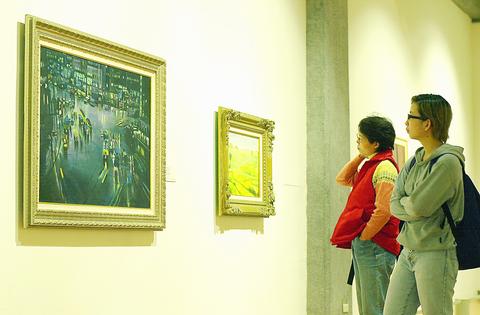
PHOTO: CHEN CHENG-CHANG, TAIPEI TIMES
The exhibition is spread out over two floors of the museum, with eight halls on the second floor separated according to decade. Highlights of the show include masterpieces such as Liao Chi-chun's (
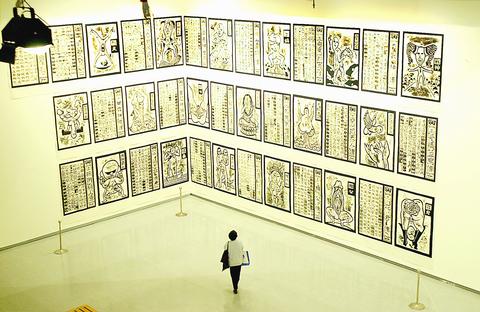
PHOTO: CHEN CHENG-CHANG, TAIPEI TIMES
Most of the first floor artwork takes an angst-ridden look at society, challenging social norms and values through mixed media presentations that range from video installations to computer-aided print outs. Yao, for example, humorously touches upon the issue of the tense relationship across the Taiwan Strait, while Hung, centers his themes around Japanese comic characters that are the only company of many children of working parents. Provocative woodcuts by Hou Chun-ming's (侯俊明) and Huang Chih-yang's (黃志陽) Space Series (1992), which feature scrolls with images of beast-like humans, touch on taboos such as sex and morality. Touching on the issue of the media and society, Wang Jun-jien's (王俊傑) multimedia installation uses repeated images to issue a scathing critique of crass contemporary commercialism.
For your information
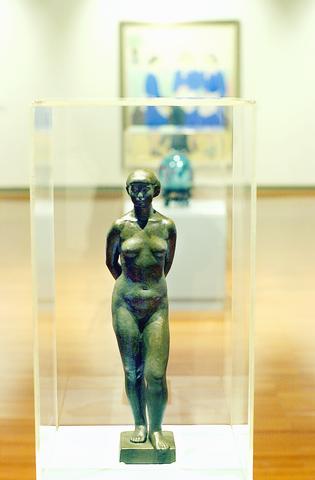
PHOTO: CHEN CHENG-CHANG, TAIPEI TIMES
What: Highlights from the Permanent Collection
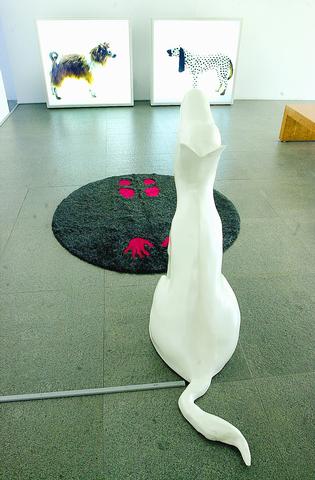
PHOTO: CHEN CHENG-CHANG, TIAIPEI TIMES
Where: Taipei fine arts museum, 181 Chung-shan N. Rd., Sec. 3, Taipei (台北美術館,台北市181中山北路3段)
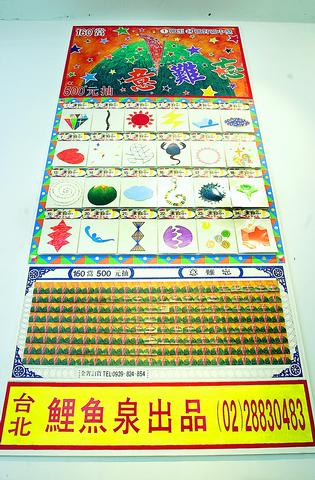
PHOTO: CHEN CHENG-CHANG, TAIPEI TIMES
When: First floor until March 25, second floor until July 8
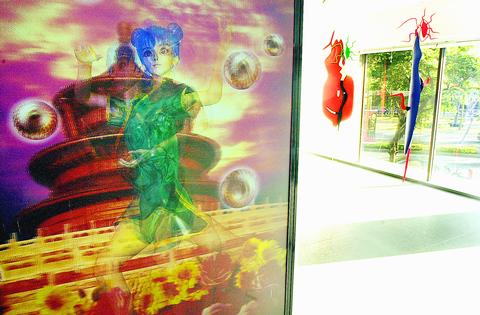
PHOTO: CHEN CHENG-CHANG, TAIPEI TIMES
At Dimensions Art Center, modern artists take a jaded look at the 20th century
"Passion for the Good Old Days" at Dimensions Art Center, with its 25 pieces, offers a sort of off-Broadway contrast to TFAM's retrospective exhibition.
This irreverent contemporary art show says goodbye to the 20th century by being fun and dynamic, and reminds one of the recently-closed Taipei Biennial at TFAM. Drawing from a variety of sources, this lively show displays the cultural mix evident in Taiwan's contemporary art. The only overlap with TFAM's Highlight show is a mixed-media installation depicting Japanese comic book characters by Hung Dung-lu (洪東祿).
The eight featured artists, each with their unique and idiosyncratic style, are placed under two categories: passion for childhood and passion of self. Some of the self-portraits are highly personal, sometimes verging on narcissistic, while others make sarcastic critiques of society and people.
Installation artist Hung Yi's (洪易) has created four-layered acrylic boxes, one of which is a model of a teahouse with the facade of a police station, suggesting that policemen prefer to sip tea, rather than patrol the streets.
Peng Hung-chih (彭弘智), another installation artist, made a dog sculpture which requires the viewer to kneel and look into its eyes. Inside the dog one sees a video of oneself as a dog eating dog food. At this point, the viewer recognizes the significance of the sound of a dog eating which is piped incessantly through the gallery's sound system.
Lee Yi-chuan (李宜全), a contemporary artist who recently returned from a two-month stay at the OMI art village in New York, made an enlarged board game which portrays commercialism and gambling as pervasive elements of our lives.
For your information
What: Passion For The Good Old Days
Where: Dimensions Art Center (帝門藝術中心), 2F, 341, Sec. 4, Jen Ai Rd., Taipei (臺北市仁愛路四段341號2樓)
When: Until Feb. 28

In the March 9 edition of the Taipei Times a piece by Ninon Godefroy ran with the headine “The quiet, gentle rhythm of Taiwan.” It started with the line “Taiwan is a small, humble place. There is no Eiffel Tower, no pyramids — no singular attraction that draws the world’s attention.” I laughed out loud at that. This was out of no disrespect for the author or the piece, which made some interesting analogies and good points about how both Din Tai Fung’s and Taiwan Semiconductor Manufacturing Co’s (TSMC, 台積電) meticulous attention to detail and quality are not quite up to

It is one of the more remarkable facts of Taiwan history that it was never occupied or claimed by any of the numerous kingdoms of southern China — Han or otherwise — that lay just across the water from it. None of their brilliant ministers ever discovered that Taiwan was a “core interest” of the state whose annexation was “inevitable.” As Paul Kua notes in an excellent monograph laying out how the Portuguese gave Taiwan the name “Formosa,” the first Europeans to express an interest in occupying Taiwan were the Spanish. Tonio Andrade in his seminal work, How Taiwan Became Chinese,

Mongolian influencer Anudari Daarya looks effortlessly glamorous and carefree in her social media posts — but the classically trained pianist’s road to acceptance as a transgender artist has been anything but easy. She is one of a growing number of Mongolian LGBTQ youth challenging stereotypes and fighting for acceptance through media representation in the socially conservative country. LGBTQ Mongolians often hide their identities from their employers and colleagues for fear of discrimination, with a survey by the non-profit LGBT Centre Mongolia showing that only 20 percent of people felt comfortable coming out at work. Daarya, 25, said she has faced discrimination since she

April 21 to April 27 Hsieh Er’s (謝娥) political fortunes were rising fast after she got out of jail and joined the Chinese Nationalist Party (KMT) in December 1945. Not only did she hold key positions in various committees, she was elected the only woman on the Taipei City Council and headed to Nanjing in 1946 as the sole Taiwanese female representative to the National Constituent Assembly. With the support of first lady Soong May-ling (宋美齡), she started the Taipei Women’s Association and Taiwan Provincial Women’s Association, where she